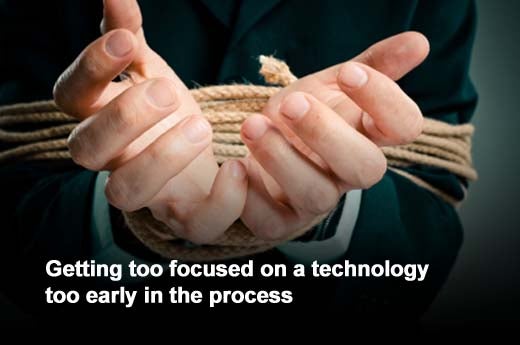Out of every 100 IT projects started, 94 will start over again at least once. Before your company launches its next package selection, implementation, or upgrade, make sure you don’t cripple the project from the start by failing to identify your requirements — the number one reason that projects spin out of control. Make sure that your company has a clear understanding of how important the requirements definition stage is, has a proven way to carry it out properly, and doesn’t skip this critical phase in the rush to get an RFP out the door.
The toughest job in the requirements definition stage is to get stakeholder agreement as a systematic, expected deliverable in the project cycle. It is absolutely essential (even on the most agile of projects) for a team to have consensus on the requirements. IAG Consulting shares what they’ve learned after over 1,000 engagements.
Click through for tips and traps when building consensus on business requirements, as identified by IAG Consulting.
It’s almost trite to say that stakeholders must feel a sense of ownership of the requirements, but IAG Consulting sees all too often a process for requirements elicitation that actually diminishes this sense of ownership. A good example is when requirements are framed in the technical jargon of IT architecture. It is impossible to get stakeholders to take ownership of requirements they don’t understand, but may be reluctant to admit.
A sound process for requirements elicitation includes:
- Holding facilitated sessions where all stakeholders are present
- Using techniques and tools that engage the non-technical participant
- Setting the expectation that the stakeholder representatives will sign off on the detailed requirements specification
Stakeholders will not participate if they feel their time is being wasted. Companies need to cut in half the amount of time they demand from users to define their requirements. After this, if it takes more than a week to produce and approve documentation of the requirements, it is likely that the original requirement will have shifted somewhat. Speed is fundamental. Any approach that is not highly accelerated is unlikely to be consistently applied over a wide range of project types.
The essence of getting speed is to use a highly disciplined approach to managing the elicitation sessions. Such an approach forces the right questions to be asked at the right times, and prevents a group from going backward to rehash decisions that have already been made. A disciplined approach is productive, comprehensive, and exciting for participants.
Stakeholders will participate in a process in which there is a clear beginning, clear momentum during the process, and a valuable product at the end. If the requirements definition process starts to wander, stakeholders lose interest, and then it is extremely difficult to rebuild their motivation and energize the project.
IAG Consulting suggests that a company use activity-based methods for managing the process — this way, large projects are broken into clear, discrete and logical components. With these activities identified, a business use case combines with data or object modeling and definition techniques to produce a more complete decomposition of the process and data requirements. Enacting objective standards enables tests on the completeness of the requirements so that quality can be assessed. Having a clear decomposition and elicitation approach enables participants to more easily keep track of progress toward completion, and understand precisely the degree of completeness expected.
The focus of requirements definition must be 100 percent on what is the business objective of the system. Don’t make these common mistakes:
- While the requirements may include non-functional specifications such as responsiveness, they should be technology-agnostic.
- Arguing the merits of one technology over another, too early in the process distracts from the need to have absolute clarity on what the technology needs to do.
- Getting too technical muddies the water on the ownership of requirements since it forces ownership away from the business stakeholder.
- Selecting a particular application package too early in the process will tend to disengage consensus building.
It is relatively easy to get consensus on all the high-level functions or use cases that a system needs and to assign priorities to them. Even for a scope as large as an ERP for a major manufacturer, we can usually scope a project to this level in a week. But this level of detail is insufficient to compare application vendors’ reliably, and it is a trap to think that consensus built at this level is adequate.
The issue is that the application may not manage the data flow in the same way that your people currently perform the work, and this won’t be apparent from a high-level view of the requirements and the proposed solution. One of three things then happens:
- The application is implemented “vanilla” and people change the way they work to accommodate the application.
- The application is customized to address the gap.
- The functionality needed cannot be implemented.
In all three cases, unless the stakeholders anticipated and accepted this change of course, then the scope of the project will increase and stakeholder satisfaction with the result will decrease. Aside from this, “vanilla” no longer exists — almost all major commercial applications today are highly configurable so the organization must know how information is to be managed across the corporation — in detail.
One of the claimed advantages of a package is that it embodies industry best practices. Focusing on this possibility can be a subtle trap. Most organizations obviously want to make a decisive leap forward in process efficiency through the implementation of a new package, so it is easy to get distracted by this prospect. However, without knowing the degree of change from the existing process that this implies, it is difficult to precisely control scope and ensure that essential aspects of functionality are not lost in shooting for this “uber-function.”
When looking at best practices, keep le Châtelier’s Principle in mind: the greater the stress you put on a system, the more the system fights back to return to its state of comfortable equilibrium. Achieving great benefit then means dealing with significant organization resistance unless consensus is first reached on how the change will impact at the grass roots of an organization.









